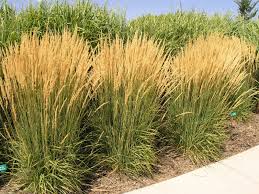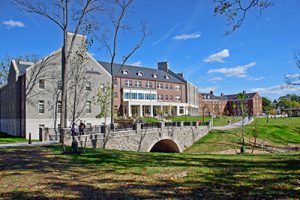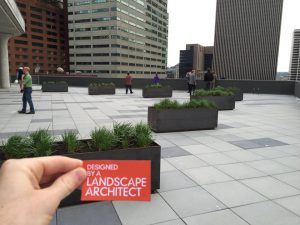Kleingers awarded ‘Cincinnati Design Award’ for work at Miami
For the second year in a row, The Kleingers Group was the proud recipient of a Cincinnati Design Award in the landscape architecture category.
This year, Kleingers won the honor award for its work on Miami’s western campus.
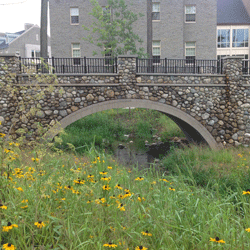
The goal of the Cincinnati Design Awards is to recognize high-quality design in the regional community and to educate the general public about the benefits of supporting quality design. Kleingers was honored to be listed among the top designers in the region.
“We really enjoyed working with Miami and the project team and are really pleased with how well it all came together,” said Lynne Nischwitz, Kleingers’ Landscape Architecture Studio Leader. “We were especially proud of how the hardscape and softscape weave together and thought it was really spectacular that we were able to expand the University’s Horticulture Walk.”
At the event, the judges thanked Kleingers for creating such a pleasing landscape.
The project began in 2014 when the University constructed three new residence halls, a dining hall, a geothermal energy plant, and two ponds.
The University’s vision for the Western campus landscape was to create a cohesive, naturalistic, and sustainable landscape that would immerse students into nature. Kleingers worked closely with the University to bring the vision to life.
The final design expanded the University’s horticulture walk, provided a central large gathering space, passive gathering spaces for each residence hall, pedestrian connections across campus, stream restoration, and the new 150’ long bridge that will look like the historic, iconic cobblestone bridges that have existed on this portion of Miami’s Western campus for many years.
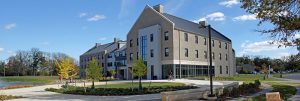
The landscape and hardscape spaces ‘weave together’ such that colorful naturalistic plantings danced into plaza areas while these plaza areas disintegrated into beautiful swathes of planting colors and textures. The interplay of movement between the prairie-style landscape and the hardscape plazas and walks unifies the entire Western campus landscape and indulges students and visitors in nature’s beauty.
Each area of the design was carefully thought out and plays a part in fulfilling the University’s vision.
New Plantings
The extensive and unique plant list includes native trees, ornamental grasses, and perennials that provide seasonal bloom and sweeping, dramatic, and naturalistic views. These plantings were extremely important to the University as they allowed for the expansion of the University Horticulture Walk.
Plantings include over 50 types of trees and a vast array of perennials and grasses. Trees included many Oak varieties such as Bur Oak, Sawtooth Oak, White Oak, Overcup Oak, Chinkapin Oak, Willow Oak, and Shingle Oak, as well as Shagbark Hickory, Dawn Redwood, Sycamore, Hardy Rubber Tree, Katsuratree, Cottonwood, Gingko, Black Tupelo, Amur Corktree as well as multiple Maple varieties to name a few. Ornamental grasses included Little Bluestem, Ice Dance Carex, Northern Sea Oats, and Autumn Moor Grass and perennials included Coneflower, Blazing Star, Russian sage, and Salvia and Sedum varieties.
Stream Restoration
The detailed design of the stream restoration creates dramatic views from the new and historic pedestrian bridges by creating pools of water in-between stream riffles. The naturalistic plantings along the stream contribute to the overall low maintenance field of native prairie grasses with pops of color. Boulders of varying colors were utilized at different points along the stream and positioned along strategic portions of the pond edge to further unify the western campus aesthetic and create rhythm with the architecture.
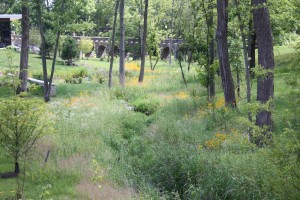
Large Gathering Spaces
The central large gathering space consists of a sunken lawn oval with amphitheater seating that diminishes into the ground, further enhancing the seamless transition of hardscape and softscape. This central gathering space provides the opportunity for organized concerts or casual use, allows for zero edge handicap accessible entry into the sunken ‘green’, and marries the hardscape and the residence hall architecture through rings of blue/black seeded aggregate that radiate out from the ‘central green’ oval and continue through the buildings and out into separate passive outdoor patio spaces.
Reviewed by a blind jury from all over the country, Kleingers was extremely honored to be recognized for its work creating a natural, cohesive and sustainable landscape.
What Plants to Plant to Beat the Heat?
As we head into the summer months and temperatures continue to rise, we often get asked, “What plants should I install that will survive and perform well throughout the summer?” As Landscape Architects, one area that we specialize in is planting design. There are many considerations to take into account when selecting the appropriate plant material – size, sun exposure, drought tolerance, salt tolerance, color, time of year that it flowers, and so on. Whether a project will have irrigation installed or not is another big factor to consider, especially during the summer. We study all of these plant characteristics to select the correct combination of plants for the specific locations on a project.
Here are some recommendations for plants that are not only drought-tolerant and heat resistant, but could also aesthetically meet the needs of your project:
Perennials:

The plants chosen by The Kleingers Group for the landscaping at the GE EPISCENTER in Dayton are designed to look great even during the heat of the summer.
1. Moonbeam Coreopsis – Coreopsis verticillata ‘Moonbeam’
Showy yellow flowers with a light airy texture. Tolerant of a wide variety of conditions including drought and heat.
2. Walker’s Low Catmint – Nepeta faassenii ‘Walker’s Low’
Showy periwinkle blue flower spikes with fragrant grey-green foliage. Attracts hummingbirds and butterflies.
3. Black Eyed Susan – Rudbeckia fulgida
Bright yellow flowers and a bold upright texture make this plant pop in any landscape. An extremely hardy plant with seed heads that persist adding winter interest to the landscape.
4. Blazing Star – Liatris spicata
Vibrant pink flower spikes emerge in late summer/early fall. This plant attracts an abundance of wildlife anywhere it is planted!
5. Purple Coneflower – Echinacea purpurea
Large pinkish-purple blooms sit atop handsome dark green foliage. Extremely durable with many varieties available.
6. Autumn Joy Sedum – Sedum ‘Autumn Joy’
Dark pink blooms emerge in fall turning into a coppery color that lasts all winter long. Blooms sit on top of broad succulent stems and leaves.
7. Russian Sage – Perovskia atriplicifolia
Tall, airy, spike-like flower clusters create a lavender blue cloud in the landscape. Flowers sit atop a finely textured aromatic foliage. Extremely drought tolerant, hardy plant.
8. Daylily – Hemerocallis ‘Stella de Oro’
Bright yellow flowers emerge above a clump of arching, linear, blade-like leaves. Great in masses as it provides color all year long.
Ornamental Grasses:
1. Feather Reed Grass – Calamagrostis acutiflora ‘Karl Foerster’
An ornamental grass with strong upright vertical lines. The plant is valued for its early bloom time and strong ability to adapt to many growing conditions.
2. Switchgrass – Panicum virgatum
An upright landscape grass with lovely blue-green foliage. In late summer, light, airy, wheat-colored flowers emerge.
Shrubs:
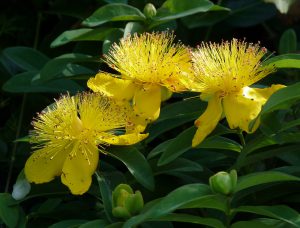
St. John’s Wort
1. Shrubby St. John’s Wort – Hypericum calycinum
A widely used low-growing evergreen shrub. The deep green glossy foliage is an attractive backdrop to the bright yellow pincushion-like flowers that emerge in early summer.
2. Blue Chip Butterfly Bush – Buddleia ‘Blue Chip’
Low-growing attractive shrub with great drought tolerance. The shrub features intense blue flower spikes that begin in June and last all season long. This shrub is incredibly fragrant and attracts many wildlife species.
As you can see, selecting the proper plant for the proper location is critical to plant survival and growth. Let us assist you in your next design!
Advocating for Landscape Architecture

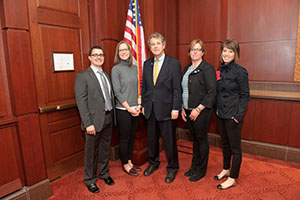 Last week, Lynne Nischwitz, the Landscape Architecture Studio Leader at the Kleingers Group, traveled to Washington DC as part of her role as Vice President of the Ohio American Society of Landscape Architects (ASLA) to advocate for landscape architecture and causes important to the profession.
Last week, Lynne Nischwitz, the Landscape Architecture Studio Leader at the Kleingers Group, traveled to Washington DC as part of her role as Vice President of the Ohio American Society of Landscape Architects (ASLA) to advocate for landscape architecture and causes important to the profession.
Each year ASLA sends landscape architects from across the country to Washington DC to raise the visibility of the profession with legislators and help promote the solutions that landscape architects can help provide to various national problems.
This year, the group was advocating for three things:
- Ensuring that bicycle and pedestrian paths and walkways continue to receive support in the latest Transportation Alternatives Program and are not subject to the same regulations as large highway projects.
- Protecting the Land and Water Conservation Fund which provides grants supporting the local park, conservation, trail, and recreation projects.
- Promoting the National Park Service Centennial challenge, ensuring money is available for the maintenance of the nation’s national parks.
The group also spoke about the importance of licensure in the landscape architecture profession. The education, experience, and examination required to earn a license ensures that licensed landscape architects can “keep the public safe from hazards, protect and maximize the use of natural systems and resources, and prevent damage to public or private property from changes in the built environment”, according to ASLA.
Lynne and fellow ASLA members met with Senator Rob Portman and Senator Sherrod Brown and Lynne also met with a representative from Steve Chabot’s office.
To learn more about the 2015 Advocacy Day or about the issues visit www.ASLA.org.
Landscape Architecture Month: Designing a Better Community
April is World Landscape Architecture Month — a time dedicated to promoting landscape architecture to students and educating others about what it means to be a landscape architect.
Landscape architects are the people responsible for designing the parks, plazas, streetscapes, and green spaces that make the outdoors healthy, sustainable and enjoyable. At the Kleingers Group, we are proud of the role our landscape architects play in moving communities forward.
This month, we asked our landscape architects about why their profession is important, why they got involved, and what projects count among their favorites.
1. Why Are Landscape Architects Important?
“Landscape architects are important because they have the ability and skills to bring many different people and professions together to create improvements for the community. LA’s look at projects from a holistic approach, searching for the best solution.” – Michael
“Without landscape architects our world would be boring! Landscape architecture is not just about making things look pretty, its about creating and transforming spaces that initiate lifestyles and allow users to get outside and enjoy quality designed spaces. Landscape architects shape our built environment, they create spaces that function but are also aesthetically pleasing and designed to enhance the user’s quality of life.” – Ryan
2. What Inspired You to Become a Landscape Architect?
“I was inspired to enter the profession of landscape architecture when my parents decided it was time to spruce up their house. I was in middle school when they hired a landscape architect to completely transform their outdoor spaces. I immediately became interested in the process from reviewing plans, to choosing materials, to looking at plants. It wasn’t until I saw the finished product and the amazing transformation happen that I knew I wanted to do this for the rest of my life. After the transformation, the way we used our outdoor spaces changed. We no longer used the inside of our house for the majority of our activities, my family was outside as much as possible enjoying the amazing spaces that were created. I knew I wanted to design these spaces so everyone could have as much fun enjoying nature as I have.” – Ryan
“I first learned about the profession of landscape architecture from my dad, as he had graduated from Ohio State with a degree in Landscape Architecture. From listening to him talk about the profession, I knew that there was a lot more to landscape architecture than just designing planting plans. It was interesting to hear his stories about happenings that had occurred in the studio while drawing or something that happened in the field. It all sounded exciting. Because my dad graduated in landscape architecture from Ohio State, I remember seeing an alumni brochure he received in the mail showing the landscape architecture studio space. That sealed the deal for me, I thought it would be really cool to work in a creative studio environment.” – Lynne
“My senior year of undergrad, I took an environmental design class where I learned about landscape architecture for the first time. It combined many of my interests of design, the outdoors, etc. and the rest is history.” – Michael
3. Do You Have a Favorite Project that You Have Worked On?
“My favorite project I worked on was the Japanese American National Museum project in Los Angeles. It is my favorite project because it was the first project I worked on from concept design all the way through construction administration. I also loved the design of the project as well as the scale. It was also fun because George Takei, Sulu, from Star Trek was on the board of trustees of the Japanese American National Museum. I remember him being at a couple of meetings. I never watched Star Trek, so, I didn’t really care, but, it was funny to come back to the office and everyone would ask if George was at the meeting because they were Star Trek fans. The project also incorporated a fountain designed by Robert Murase.” – Lynne
“One of my favorite projects is one of my earliest ones that I did while working with LDR/HNTB in Maryland, called Carroll Creek. It transformed a desolate flood control infrastructure into an urban park, generating new business and residences for the city of Frederick, MD.” – Michael
“My favorite project I have worked on would be Miami University’s Western Campus. It was a large project with many different aspects. This project was a fast-paced project that allowed me to express a lot of creative freedom. Because the project was so fast paced, I was able to see how the design translated from paper to a real life application while the design was still fresh in my mind, which is pretty rare in our profession. Also, most my family members went to Miami University, so when we go up to oxford it also allows me take them to the project and brag about how cool the finished product is!” -Ryan
4. What Is Your Favorite Part of The Job?
“My favorite part of being a LA is seeing the physical impact on the community that our designs/projects have. To go to a public project (or a private one) and see people using it is the best reward.” – Michael
“I really enjoy most aspects of the profession because it is ever changing. I would say my absolute favorite portion would be the creative freedom we, as designers, are allowed. No two projects are alike, so it allows us to create unique new spaces with each project. The job is never monotonous and always keeps you interested and on your toes!” – Ryan
5. What Have You Done to Educate Others About the Profession?
“I serve as the Ohio Chapter VP of ASLA and therefore, I am working with our state legislators on advocacy for the profession. In fact, next week, I go to Washington D.C. to speak to our senators and representatives about issues relative to the landscape architecture profession. I have visited a class of kindergarteners and talked to them about landscape architecture and what we do as professionals. To show them in a way that they can relate, I asked them what they liked about parks and wrote down the list of things they liked to do at parks. Then, in a charrette style, right in front of them, I designed a park with all the elements they love. While doing so, I opened up their eyes that not only do landscape architects think about the fun stuff in a park, such as the playstructures, but also plan how the overall park is master planned and designed. For example, how you get to a park, (driving, walking or riding your bike), restroom facilities, parking areas, shade, and seating etc. and how all these elements work together.” – Lynne
“It is a constant education to explain to people that LA’s do more than backyards, golf courses or plants. To help get that message out there, I have spoken at conferences, public meetings, and just converse with people in general.” – Michael

